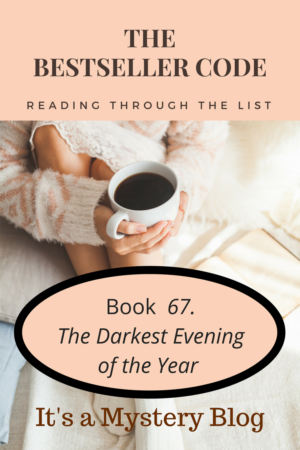The Silent Wife by A. S. A. Harrison is next up on our 100 Bestsellers List reading challenge. This novel is categorized as a Psychological Thriller.
This post does contain spoilers.
The Silent Wife: A Novel* by A. S. A. Harrison


*Amazon Affiliate link)
In The Silent Wife, we are introduced to Todd and Jodi, a couple who appear to have it all. Todd is a building contractor in Chicago and Jodi is a psychotherapist that sees a few carefully selected clients (no difficult cases or life-threatening issues) from her home. They’ve been a couple for over twenty years and live in a beautiful twenty-seventh floor condo overlooking the lake. Jodi takes great care and pride in keeping herself in good physical shape, careful grooming, and providing the perfect home atmosphere for Todd – fresh flowers, hors d’oeuvre and wine as soon as he gets home. And yet, all is not perfect. Todd often doesn’t come home and Jodi knows the reasons why, but carefully ignores the affairs. Todd’s business dealings are always on a knife’s edge, threatening to implode, but he never tells Jodi about any financial problems. Silence is the name of the game.
It’s The Title, Again
In my review of The Hotel on the Corner of Bitter and Sweet, I wrote about the importance that The Bestseller Code algorithm attributes to the title of a book. In Chapter 5 of The Bestseller Code the authors explain that book titles beginning with “The” are much more common on the bestseller list than those that begin with “A.”
The specificity of the word “The” asks us to trust that this goldfinch has more relevance – enough to hold an entire story symbolically, emotionally, or structurally – for more than three hundred pages.
“The” remains the most successful way to begin a title because it is a word that implies agency focused somewhere, be that focus on a place, on an event, on an object, or somewhere else. The title gives us a clue about how to relate to the story that follows.
In addition to the title beginning with “The,” this title also includes a sociocultural role:
When it comes to sociocultural roles, the word “wife” is popular in bestselling titles, but it is always qualified. The title is not just The Wife. She has more to contend with than this. Titles about a woman in marriage that hit the lists are titles such as The Silent Wife, The Paris Wife, A Reliable Wife. The names of these novels are meant to make us wonder what happens to this woman when put in relationship to Paris, to silence, to reliability as well as, given what “wife” implies, to her husband. How do her options and her likely conflicts change?
…any quick look at the bestseller list will tell you that troubled marriage appears to be a big hook for the reading market at the moment. The books making the lists are evidence of our contemporary fascination with the roles of women in their place in the family, in marriage, and in the public sphere.
The Bestseller Code by Jodie Archer & Matthew L. Jockers. Chapter 5. Pages 150 – 154
Silent AND Wife
So here we have The Silent Wife and both words – silent, wife – have major implications in the novel. Jodi is silent, prides herself on her silence, whether it be about events and issues from her childhood or dealing with Todd’s recurring infidelities. Silence means she can ignore the issue. If it’s not talked about, it doesn’t exist. Both Jodi and Todd view silence as power and it’s been a sustaining feature of their relationship.
He breaks the connection and it dawns on him that this is typical of his and Jodi’s life together: the stubborn pretense, the chasms of silence, the blind forging ahead. He must have known this, but the weirdness of it, the aberrance, has somehow never struck him. Other couples are loud, vocal, off and on again, working things out, but with Jodi and him it’s all dissimulation. Put up a front, go through the motions, don’t say a word. Act as if all is well and all will be well. Jodi’s great gift is her silence, and he has always loved this about her, that she knows how to mind her own business, keep her own counsel, but silence is also her weapon. The woman who refuses to object, who doesn’t yell and scream – there’s strength in that, and power.
Jodi considers herself to be Todd’s wife and passes herself off publicly as Mrs. Gilbert, but she never actually married Todd, even though he proposed to her several times. The lack of a marriage certificate is a major contributor to the complete breakdown of their relationship and, ultimately, murder, and we learn in the second paragraph of the book who will be murdered and who will be the murderer.
Psychological thriller
I don’t consider this novel to be a “thriller” as much as it is suspenseful. As stated above, we are told right off who will be killed and who will do the killing. The questions to be answered are why and how. The suspense comes in watching the disintegration of the “marriage” – Jodi’s carefully structured world and Todd’s lifetime of self-delusion shatter in pieces – and in seeing just how far a person can be backed into a corner before self-preservation takes over. While neither Jodi or Todd are particularly lovable, they are believable and it doesn’t take too much of a leap to understand how any one of us might act similarly, given similar circumstances.
Author A. S. A. Harrison was a psychotherapist, in addition to writer, so Jodi is a believable psychotherapist, at least to one who has never gone through any type of therapy. Sometimes the technical descriptions of psychoanalytical theories is a little heavy, but overall, they play well into the story line and provide insight into both Todd and Jodi’s characters. Both Todd and Jodi had deeply flawed childhoods that impacted who they became as adults and how they view marriage and life, although Jodi is able to gloss over and “forget” the worst of her experiences. Jodi naming her dog “Freud” is a not-so-subtle reminder, though, that no experiences are ever truly forgotten. They dwell in our unconscious mind and govern our behavior throughout our lives. Harrison’s message in The Silent Wife seems to be that, instead of using silence as an avoidance technique, Jodi and Todd (and maybe each and every one of us?) would have benefited by bringing issues and experiences to the light of day, examining them, and coming to some sort of resolution. Considering the end resolution for Todd in this novel, who can argue with that message?
Related posts:
- Book-beginnings, a discussion of the first line of the novel
- Karen’s review from a reader’s perspective
- Roberta’s review from a writer’s perspective
You can also join us on social media:
__________________
What are we reading next?
If you ever have questions about what we are reading next or when we’re starting the next discussion, check the 100 Book List tab in the navigation bar at the top of the blog. Links in the list go to the landing page from this blog where the discussion starts. However, this is an open-ended challenge so feel free to jump in with any of the books at any time after its start date.
The next book is number 81. The Art of Racing in the Rain by Garth Stein (2008) – Discussion begins August 7, 2017
Literary fiction told from a dog’s point of view


















